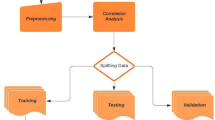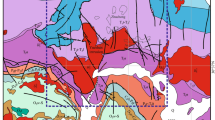Abstract
Formation resistivity (Rt) is a vital property for formation evaluation and calculation of water saturation and hydrocarbon in places. Rt can be estimated using core analysis and well logging. However, these processes are expensive and time-consuming. In addition, due to tool failure, and poor wellbore conditions, part of the well logging records may be missed. Hence, the objective of this paper is to predict the true formation resistivity in complex carbonate sections using decision tree (DT) and Random Forests (RF) machine learning (ML) techniques as a function of available well logging data. A data set of 5500 data points were collected from two vertical wells in carbonate formation. The data includes gamma-ray, bulk density, neutron density, compressional wave transit time, shear transient time, and the corresponding Rt. Data from Well-1 were used to develop the DT and RF models with training to the testing splitting ratio of 70:30. Dataset from Well-2 was used to validate the optimized models. The results showed the capabilities of the ML models to predict the formation resistivity from well-logging data. The correlation coefficient (R) between the actual and the predicted output values and the root mean square error (RMSE) was used to evaluate the models performance. R value for the RF model was found to be 0.99, and 0.98 for the training and the testing stages with a validation R value of 0.94. The RMSE for the developed models was less than 0.38 for training, testing, and validation stages. Using ML to predict the formation resistivity can fill the missing gaps in log tracks and save money by removing resistivity logs running in all offset wells in the same field.





Similar content being viewed by others
Abbreviations
- API:
-
American petroleum institute
- ANFIS:
-
Adaptive network-based fuzzy interference system
- ANN:
-
Artificial neural networks
- CGR:
-
Computed gamma ray
- DT:
-
Decision tree
- DTC:
-
Compressional transient time
- DTS:
-
Shear transient time
- FN:
-
Functional networks
- GR:
-
Gamma ray
- ILD:
-
Induction log deep
- ILM:
-
Induction log medium
- LLD:
-
Deep latero-log
- LWD:
-
Logging while drilling
- RMSE:
-
Root mean squared error
- NPHI:
-
Neutron porosity
- R:
-
Correlation coefficient
- RF:
-
Random forests
- RHOB:
-
Bulk density
- RMSE:
-
Root mean squared error
- R t :
-
True resistivity
- R xo :
-
Flushed zone resistivity
- SGR:
-
Spectral gamma ray
- SVM:
-
Support vector machines
- S w :
-
Water saturation
- S xo :
-
Flushed zone water saturation
- w :
-
Water
- xo :
-
Flushed zone
References
Asquith, G.; Krygowski, D.: Basic Well Log Analysis for Geologists, 2nd edn. The American Association of Petroleum Geologists (2004)
Evenick, J.: Introduction to Well Logs and subsurface maps. PennWell Corp., Nashville (2008)
Serra, O.: Fundamentals of Well-Log Interpretation (1984)
Archie, G.E.: The electrical resistivity log as an aid in determining some reservoir characteristics. SPE Repr. Ser. 146, 9–16 (1942). https://doi.org/10.2118/942054-g
Zhong, H.; He, Y.; Yang, E.; Bi, Y.; Yang, T.: Modeling of microflow during viscoelastic polymer flooding in heterogenous reservoirs of Daqing Oilfield. J. Pet. Sci. Eng. 210, 110091 (2022). https://doi.org/10.1016/J.PETROL.2021.110091
Yang, E.; Fang, Y.; Liu, Y.; Li, Z.; Wu, J.: Research and application of microfoam selective water plugging agent in shallow low-temperature reservoirs. J. Pet. Sci. Eng. 193, 107354 (2020). https://doi.org/10.1016/J.PETROL.2020.107354
Mavko, G.; Mukerji, T.; Dovorkin, J.: The Rock Physics Handbook—Tools for Seismic Analysis of Porous Media, 2nd edn (2009)
Timur, A.: Advances in well logging. J. Pet. Technol. 34, 1181–1185 (1982). https://doi.org/10.2118/10947-pa
Rajabi, M.; Bohloli, B.; Gholampour Ahangar, E.: Intelligent approaches for prediction of compressional, shear and Stoneley wave velocities from conventional well log data: a case study from the Sarvak carbonate reservoir in the Abadan Plain (Southwestern Iran). Comput. Geosci. 36, 647–664 (2010). https://doi.org/10.1016/j.cageo.2009.09.008
Mohaghegh, S.: Virtual-intelligence applications in petroleum engineering: part I—artificial neural networks. J. Pet. Technol. 52, 64–73 (2000). https://doi.org/10.2118/58046-jpt
Elsafi, S.H.: Artificial Neural Networks (ANNs) for flood forecasting at Dongola Station in the River Nile, Sudan. Alex. Eng. J. 53, 655–662 (2014). https://doi.org/10.1016/j.aej.2014.06.010
Doraisamy, H.; Ertekin, T.; Grader, A.S.: Key parameters controlling the performance of neuro-simulation applications in field development. In: Proceedings—SPE Annual Western Regional Meeting, pp. 233–241. Soc Pet Eng (SPE) (1998)
Gamal, H.; Alsaihati, A.; Elkatatny, S.: Predicting the rock sonic logs while drilling by random forest and decision tree-based algorithms. J. Energy Resour. Technol. (2022). https://doi.org/10.1115/1.4051670
Alsaihati, A.; Elkatatny, S.; Gamal, H.: Rate of penetration prediction while drilling vertical complex lithology using an ensemble learning model. J. Pet. Sci. Eng. 208, 109335 (2022). https://doi.org/10.1016/j.petrol.2021.109335
Al-Abdul Jabbar, A.; Elkatatny, S.; Mahmoud, M.; Abdulraheem, A.: Predicting formation tops while drilling using artificial intelligence. In: Society of Petroleum Engineers—SPE Kingdom of Saudi Arabia Annual Technical Symposium and Exhibition 2018, SATS 2018. Society of Petroleum Engineers (2018)
Elkatatny, S.; Mahmoud, M.: Development of new correlations for the oil formation volume factor in oil reservoirs using artificial intelligent white box technique. Petroleum 4, 178–186 (2018). https://doi.org/10.1016/j.petlm.2017.09.009
Gamal, H.; Abdelaal, A.; Elkatatny, S.: Machine learning models for equivalent circulating density prediction from drilling data. ACS Omega 8, acsomega.1c04363 (2021). https://doi.org/10.1021/ACSOMEGA.1C04363
Gamal, H.; Abdelaal, A.; Alsaihati, A.; Elkatatny, S.; Abdulraheem, A.: Artificial Neural Network Model for Predicting the Equivalent Circulating Density from Drilling Parameters (2021)
Gamal, H.; Elkatatny, S.; Alsaihati, A.; Abdulraheem, A.: Intelligent prediction for rock porosity while drilling complex lithology in real time. Comput. Intell. Neurosci. (2021). https://doi.org/10.1155/2021/9960478
Gowida, A.; Elkatatny, S.; Abdulraheem, A.: Application of artificial neural network to predict formation bulk density while drilling. Petrophysics 60, 660–674 (2019). https://doi.org/10.30632/pjv60n5-2019a9
Zazoun, R.S.: Fracture density estimation from core and conventional well logs data using artificial neural networks: the Cambro-Ordovician reservoir of Mesdar oil field, Algeria. J. Afr. Earth Sci. 83, 55–73 (2013). https://doi.org/10.1016/j.jafrearsci.2013.03.003
Siddig, O.; Gamal, H.; Elkatatny, S.; Abdulraheem, A.: Real-time prediction of Poisson’s ratio from drilling parameters using machine learning tools. Sci. Rep. 11, 1–13 (2021). https://doi.org/10.1038/s41598-021-92082-6
Siddig, O.; Gamal, H.; Elkatatny, S.; Abdulraheem, A.: Applying different artificial intelligence techniques in dynamic Poisson’s ratio prediction using drilling parameters. J. Energy Resour. Technol. (2022). https://doi.org/10.1115/1.4052185
Siddig, O.M.; Al-Afnan, S.F.; Elkatatny, S.M.; Abdulraheem, A.: Drilling data-based approach to build a continuous static elastic moduli profile utilizing artificial intelligence techniques. J. Energy Resour. Technol. (2022). https://doi.org/10.1115/1.4050960
Abdelaal, A.; Elkatatny, S.; Abdulraheem, A.: Data-driven modeling approach for pore pressure gradient prediction while drilling from drilling parameters. ACS Omega (2021). https://doi.org/10.1021/acsomega.1c01340
Abdelaal, A.; Elkatatny, S.; Abdulraheem, A.: Formation Pressure Prediction from Mechanical and Hydraulic Drilling Data Using Artificial Neural Networks (2021)
Azimi, H.; Shiri, H.; Malta, E.R.: A non-tuned machine learning method to simulate ice-seabed interaction process in clay. J. Pipeline Sci. Eng. 1, 379–394 (2021). https://doi.org/10.1016/J.JPSE.2021.08.005
Moazzeni, A.; Haffar, M.A.: Artificial intelligence for lithology identification through real-time drilling data. J. Earth Sci. Clim. Change 06, 1–4 (2015). https://doi.org/10.4172/2157-7617.1000265
Salehi, M.M.; Rahmati, M.; Karimnezhad, M.; Omidvar, P.: Estimation of the non records logs from existing logs using artificial neural networks. Egypt. J. Pet. 26, 957–968 (2017). https://doi.org/10.1016/j.ejpe.2016.11.002
Sbiga, H.; Mousa, N.: Prediction of true resistivity and resistivity index using neural networks with different combinations of wireline logs. In: Society of Petroleum Engineers—SPE North Africa Technical Conference and Exhibition 2015, NATC 2015, pp. 1105–1122. Society of Petroleum Engineers (2015)
Ważny, J.; Stefaniuk, M.; Cygal, A.: Estimation of electrical resistivity using artificial neural networks: a case study from Lublin Basin, SE Poland. Acta Geophys. 69, 631–642 (2021). https://doi.org/10.1007/s11600-021-00554-0
Darling, T.: Well logging and formation evaluation. Well Logging Form. Eval. (2005). https://doi.org/10.1016/B978-0-7506-7883-4.X5000-1
Thunder, M.; Moore, D.S.; McCabe, G.P.: Introduction to the practice of statistics. Math. Gaz. 79, 252 (1995). https://doi.org/10.2307/3620137
Funding
No external fund for this research and the authors would like to thank KFUPM for giving permission to publish this work.
Author information
Authors and Affiliations
Contributions
The manuscript was written through the contributions of all authors. All authors have approved the final version of the manuscript.
Corresponding author
Ethics declarations
Conflict of interest
The authors declare that there is no conflict of interest regarding the publication of this paper.
Rights and permissions
About this article
Cite this article
Ibrahim, A.F., Abdelaal, A. & Elkatatny, S. Formation Resistivity Prediction Using Decision Tree and Random Forest. Arab J Sci Eng 47, 12183–12191 (2022). https://doi.org/10.1007/s13369-022-06900-8
Received:
Accepted:
Published:
Issue Date:
DOI: https://doi.org/10.1007/s13369-022-06900-8




